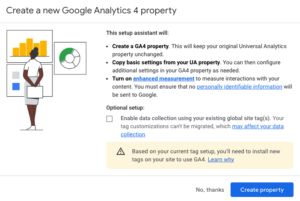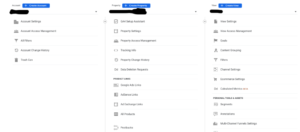In case you missed the news (or the banner at the top of your Universal Google Analytics page), some big changes are coming to Google Analytics.
As of July 1, 2023, Universal Google Analytics will be sunsetted into the past and Google Analytics 4 will become the new analytics platform for Google’s suite of apps, as well as websites with Google tags.
TIP: New to the world of Google Analytics? Get started with “An Introduction to Navigating Social Media Analytics.”
What is Google Analytics 4?
While change can be difficult to accept, Google Analytics 4 offers plenty of new features that help to make it a much more powerful tool for PR pros and marketers in the long run. Some of the most notable new additions include:
- the ability to collect website and app data together in one location;
- a focus on event-based, rather than session-based, data;
- new and improved privacy controls;
- improvements to reporting, including the introduction of custom reports.

However, if you currently use Universal Google Analytics, you will only be able to view your data for a short time after the official switch on July 1, 2023. That means if you rely on previous data, you should download it before July 1.
Why Do PR/Social Media Pros Need to Know?
Even if you do not specifically work with the Google Analytics interface as part of your role, savvy PR pros and social media marketers should still be aware of the impending changes.
As a PR pro, you may send out a press release or pitch a story that gets placed with a link back to your brand’s website — and Google Analytics is the best way to evaluate if that story placement drove an increase in website views or other actions taken. Similarly, it’s important for social media pros to track the links posted to each channel to better prove return on investment (ROI) and adjust their brand’s social media strategy as necessary.
Additionally, being informed about the latest changes helps to position you as a thought leader who keeps up-to-date on current trends in the digital space. In an agency setting, providing this kind of counsel can be invaluable to clients!
How Should I Prepare?
One of the best parts about Google Analytics 4 is that you can use it simultaneously with Universal Google Analytics, meaning you can start collecting data now and make sure it’s set up properly before the “official” switch next year.

The easiest way to set up Google Analytics 4 is to go through the set-up wizard in your Universal Google Analytics.
- Step #1: Go into your desired property and click on the gear icon for admin.
- Step #2: Pick the property you would like to switch to Google Analytics 4.
- Step #3: Choose the Google Analytics 4 Set Up Wizard. You can follow the steps or prepare yourself by taking some of the Google Analytics 4 courses via Google’s Skillshop.
- Step #4: Select “Get Started” under “I want to set up a new Google property.”

After successfully completing these steps, Google will automatically set up a new Google Analytics 4 property that migrates information from your current Universal Google Analytics. If your property was already tagged with Google Tags (aka “gtags”), your site will start collecting and showing data within 48 hours after selecting “enable data collection using existing tags.”
If your website was tagged with analytics tags rather than gtags, you will need to re-tag your website with gtags in order to start collecting data.
You will then be able to create a custom dashboard, generate customized reports, and view data from apps, websites, and ads all in one place.
For the latest information on the transition to Google Analytics 4, be sure to bookmark Google’s official support page.
Looking for more ways to evaluate your PR and social media efforts? The Scooter Media blog is full of helpful resources, including:


